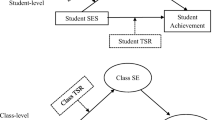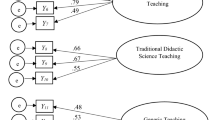Abstract
This research aims to scrutinize the moderating effect of teacher interaction on the relationships between students’ self-efficacy and achievement in mathematics in three countries, Korea, Singapore, and the USA. We analyzed the Trends in International Mathematics and Science Study (TIMSS) 2015 data with hierarchical linear modeling. The findings show that in each country, different types of teacher interaction moderate the relationships between students’ self-efficacy and achievement in mathematics. Also, when moderated relationships are found, Korean students with lower self-efficacy are likely to have higher achievement when teachers interact with each other very often. Singaporean students across all self-efficacy levels are expected to have advantages of high achievement from teachers interacting with other teachers. However, US students have similar achievement although teachers have frequent interaction with other teachers. We suggest several implications: To improve educational systems, it is necessary to consider which type of teacher interaction is common in that specific context as well as to examine how teacher interaction moderates the relationships between students’ self-efficacy and achievement in mathematics.



Similar content being viewed by others
References
Bandura, A. (Ed.). (1995). Self-efficacy in changing societies. New York: Cambridge University Press.
Bandura, A. (1997). Self-efficacy: The exercise of control. New York: W.H. Freeman and Company.
Bandura, A. (2000). Self-efficacy. In A. E. Kazdin (Ed.), Encyclopedia of psychology (pp. 212–213). Washington, DC: American Psychological Association.
Blömeke, S., & Kaiser, G. (2014). Homogeneity or heterogeneity? Profiles of opportunities to learn in primary teacher education and their relationship to cultural context and outcomes. In S. Blömeke, F.-J. Hsieh, G. Kaiser, & W. Schmidt (Eds.), International perspectives on teacher knowledge, beliefs and opportunities to learn: TEDS-M results (pp. 299–325). Dordrecht: Springer.
Briscoe, C., & Peters, J. (1997). Teacher collaboration across and within schools: supporting individual change in elementary science teaching. Science Education, 81(1), 51–65.
Chan, C. K. K., & Pang, M. F. (2006). Teacher collaboration in learning communities. Teaching Education, 17(1), 1–5. https://doi.org/10.1080/10476210500527899.
Chaney, B., Jocelyn, L., Levine, D., Mule, T., Rizzo, L., Roey, S., et al. (2001). User’s guide for the Third International Mathematics and Science Study (TIMSS) (NCES 2001-065). Washington, DC: U.S. Department of Education. National Center for Education Statistics.
Cheung, K. C., Mak, S. k., & Sit, P. s. (2018). Resolving the attitude–achievement paradox based on anchoring vignettes: evidences from the PISA 2012 mathematics study. Asia Pacific Education Review, 19(3), 389–399. https://doi.org/10.1007/s12564-018-9526-9.
Cramer, R. J., Neal, T. M. S., & Brodsky, S. L. (2009). Self-efficacy and confidence: theoretical distinctions and implications for trial consultation. Consulting Psychology Journal: Practice and Research, 61(4), 319–334. https://doi.org/10.1037/a0017310.
Di Martino, P., & Zan, R. (2010). ‘Me and maths’: towards a definition of attitude grounded on students’ narratives. Journal of Mathematics Teacher Education, 13, 27–48. https://doi.org/10.1007/s10857-009-9134-z.
Di Martino, P., & Zan, R. (2011). Attitude toward mathematics: a bridge between beliefs and emotions. ZDM Mathematics Education, 43, 471–482. https://doi.org/10.1007/s11858-011-0309-6.
Di Martino, P., & Zan, R. (2015). The construct of attitude in mathematics education. In B. Pepin & B. Roesken-Winter (Eds.), From beliefs to dynamic affect systems in mathematics education: exploring a mosaic of relationships and interactions (pp. 51–72). Cham: Springer.
DuFour, R. (2004). What is a “professional learning community”? Educational Leadership, 61(8), 6–11.
Fearon, J. D. (2003). Ethnic and cultural diversity by country. Journal of Economic Growth, 8(2), 195–222.
Foy, P. (2017). TIMSS 2015 user guide for the international database. Chestnut Hill: TIMSS & PIRLS International Study Center, Lynch School of Education, Boston College and International Association for the Evaluation of Educational Achievement (IEA).
Foy, P., Brossman, B., & Galia, J. (2012). Scaling the TIMSS and PIRLS 2011 achievement data. Chestnut Hill: TIMSS & PIRLS International Study Center, Lynch School of Education, Boston College and International Association for the Evaluation of Educational Achievement (IEA).
Gajda, R., & Koliba, C. J. (2008). Evaluating and improving the quality of teacher collaboration: a field-tested framework for secondary school leaders. NASSP Bulletin, 92(2), 133–153. https://doi.org/10.1177/0192636508320990.
Goddard, Y. L., Goddard, R. D., & Tschannen-Moran, M. (2007). A theoretical and empirical investigation of teacher collaboration for school improvement and student achievement in public elementary schools. Teacher College Record, 109(4), 877–896.
Grossman, P., Wineburg, S., & Woolworth, S. (2001). Toward a theory of teacher community. Teacher College Record, 106(6), 942–1012.
Hairon, S., & Dimmock, C. (2012). Singapore schools and professional learning communities: teacher professional development and school leadership in an Asian hierarchical system. Educational Review, 64(4), 405–424. https://doi.org/10.1080/00131911.2011.625111.
Hargreaves, A. (1994). Changing teachers, changing times: teachers’ work and culture in the postmodern age. New York: Teachers College Press.
Hindin, A., Morocco, C. C., Mott, E. A., & Aguilar, C. M. (2007). More than just a group: teacher collaboration and learning in the workplace. Teachers and Teaching, 13(4), 349–376. https://doi.org/10.1080/13540600701391911.
Hord, S. M. (1997). Professional learning communities: Communities of continuous inquiry and improvement. Austin, TX: Southwest Educational Development Laboratory.
Hwang, J., Runnalls, C., Bhansali, S., Navaandamba, K., & Choi, K. (2018). “Can I do well in mathematics reasoning?” Comparing US and Finnish students’ attitude and reasoning via TIMSS 2011. Educational Research and Evaluation, 23(7–8), 328-348. https://doi.org/10.1080/13803611.2018.1500293.
Jin, S., & Pang, J. (2014). An analysis of strengths and weaknesses in the study of elementary mathematics lessons via teacher learning community. Education of Primary School Mathematics, 17(3), 189–203. https://doi.org/10.7468/jksmec.2014.17.3.189 (in Korean).
Johnson, B. (2003). Teacher collaboration: good for some, not so good for others. Educational Studies, 29(4), 337–350. https://doi.org/10.1080/0305569032000159651.
Kim, T. K., Solomon, P., & Zurlo, K. A. (2009). Applying hierarchical linear modeling (HLM) to social work administration research. Administration in Social Work, 33(3), 262–277. https://doi.org/10.1080/03643100902987739.
Kim, R. Y., Ham, S.-H., & Paine, L. W. (2011). Knowledge expectations in mathematics teacher preparation programs in South Korea and the United States: towards international dialogue. Journal of Teacher Education, 62(1), 48–61. https://doi.org/10.1177/0022487110381999.
Lim, S. Y., & Chapman, E. (2015). Identifying affective domains that correlate and predict mathematics performance in high-performing students in Singapore. Educational Psychology, 35(6), 747–764. https://doi.org/10.1080/01443410.2013.860221.
Little, J. W. (1990). The persistence of privacy: autonomy and initiative in teachers’ professional relations. Teacher College Record, 91(4), 509–536.
Martin, M. O., Mullis, I. V. S., & Hooper, M. (Eds.). (2016). Methods and procedures in TIMSS 2015. Chestnet Hill: TIMSS & PIRLS International Study Center, Lynch School of Education, Boston College and International Association for the Evaluation of Educational Achievement (IEA).
Mcleod, D. B. (1994). Research on affect and mathematics learning in the JRME: 1970 to present. Journal for Research in Mathematics Education, 25(6), 637–647.
Meirinka, J. A., Imantsb, J., Meijerc, P. C., & Verloopa, N. (2010). Teacher learning and collaboration in innovative teams. Cambridge Journal of Education, 40(2), 161–181. https://doi.org/10.1080/0305764X.2010.481256.
MetLife Foundation. (2009). The MetLife survey of the American teacher: Collaborating for student success. Retrieved from http://files.eric.ed.gov/fulltext/ED509650.pdf. Accessed 27 Dec 2017.
Mullis, I. V. S., Martin, M. O., Foy, P., & Hooper, M. (2016). TIMSS 2015 international results in mathematics. Retrieved from http://timssandpirls.bc.edu/timss2015/international-results/. Accessed 17 Nov 2017.
Pajares, F., & Graham, L. (1999). Self-efficacy, motivation constructs, and mathematics performance of entering middle school students. Contemporary Educational Psychology, 24, 124–139. https://doi.org/10.1006/ceps.1998.0991.
Polikoff, M. S. (2015). How well aligned are textbooks to the common core standards in mathematics? American Educational Research Journal, 52(6), 1185–1211. https://doi.org/10.3102/0002831215584435.
Raudenbush, S. W., & Bryk, A. S. (2002). Hierarchical linear models: applications and data analysis methods (2nd ed.). Thousand Oaks: Sage.
Raudenbush, S. W., Bryk, A. S., & Congdon, R. (2013). HLM 7.01 for Windows [computer software]. Skokie: Scientific Software International, Inc.
Reeves, P. M., Pun, W. H., & Chung, K. S. (2017). Influence of teacher collaboration on job satisfaction and student achievement. Teaching and Teacher Education, 67, 227–236. https://doi.org/10.1016/j.tate.2017.06.016.
Robinson, W. S. (1950). Ecological correlations and the behaviour of individuals. American Sociological Review, 15(3), 351–357.
Rogoff, B., Matusov, E., & White, C. (1996). Models of teaching and learning: participation in a community of learners. The handbook of education and human development, 388–414.
Ronfeldt, M., Farmer, S. O., McQueen, K., & Grissom, J. A. (2015). Teacher collaboration in instructional teams and student achievement. American Educational Research Journal, 52(3), 475–514. https://doi.org/10.3102/0002831215585562.
Shen, C., & Tam, H. P. (2008). The paradoxical relationship between student achievement and self-perception: a cross-national analysis based on three waves of TIMSS data. Educational Research and Evaluation, 14(1), 87–100. https://doi.org/10.1080/13803610801896653.
Sherin, M. G., Mendez, E. P., & Louis, D. A. (2004). A discipline apart: the challenges of ‘Fostering a Community of Learners’ in a mathematics classroom. Journal of Curriculum Studies, 36(2), 207–232. https://doi.org/10.1080/0022027032000142519.
Skemp, R. R. (1976). Relational understanding and instrumental understanding. Mathematics Teaching, 77, 20–26.
Snijders, T. A. B., & Bosker, R. J. (1999). Multilevel analysis: an introduction to basic and advanced multilevel modeling. Thousand Oaks: Sage.
Spillane, J. P., Kim, C. M., & Frank, K. A. (2012). Instructional advice and information providing and receiving behavior in elementary schools: exploring tie formation as a building block in social capital development. American Educational Research Journal, 49(6), 1112–1145. https://doi.org/10.3102/0002831212459339.
Stankov, L., Morony, S., & Lee, Y. P. (2014). Confidence: the best non-cognitive predictor of academic achievement? Educational Psychology, 34(1), 9–28. https://doi.org/10.1080/01443410.2013.814194.
Wilkins, J. L. M. (2004). Mathematics and science self-concept: an international investigation. Journal of Experimental Education, 72(4), 331–346. https://doi.org/10.3200/JEXE.72.4.331-346.
Author information
Authors and Affiliations
Corresponding author
Additional information
Publisher’s note
Springer Nature remains neutral with regard to jurisdictional claims in published maps and institutional affiliations.
Rights and permissions
About this article
Cite this article
Hwang, J., Ham, Y. Relationships between self-efficacy and achievement moderated by teacher interaction: an international comparison study. Math Ed Res J 33, 135–162 (2021). https://doi.org/10.1007/s13394-019-00280-3
Received:
Revised:
Accepted:
Published:
Issue Date:
DOI: https://doi.org/10.1007/s13394-019-00280-3




